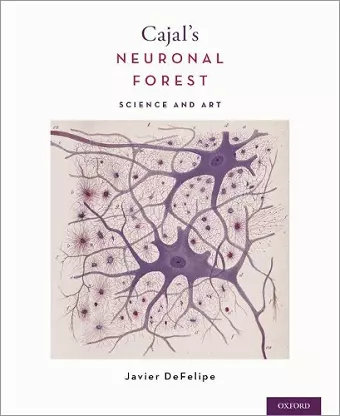Cajal's Neuronal Forest
Science and Art
Format:Hardback
Publisher:Oxford University Press Inc
Published:21st Dec '17
Should be back in stock very soon

Winner of the BMA Illustrated Book Award 2018!
Cajal's Neuronal Forest: Science and Art continues the tradition set forth by its sister volume Cajal's Butterflies of the Soul (OUP, 2009). This new collection contains hundreds of beautiful rarely-seen-before figures produced throughout the nineteenth century and the beginning of the twentieth century by famed father-of-modern-neuroscience Santiago Ramón y Cajal (1852-1934) and his contemporaries. Cajal was captivated by the beautiful shapes of the cells of the nervous system. He and his fellow scientists saw neurons as trees and glial cells as bushes. Given their high density and arrangement, neurons and glial resembled a thick forest, a seemingly impenetrable terrain of interacting cells mediating cognition and behavior. In unraveling the mysteries of the brain, these researchers encountered an almost infinite number of cellular forms with an extraordinary beauty, which they could not help but put pen to paper, allowing them to discover a new artistic world- the neuronal forest- that gave free rein not only to their imagination, but to a new way of viewing the brain as well. This book has been divided into two parts. The first focuses on the scientific atmosphere in Cajal's times, on the history of the neuron, and the anatomical challenge posed in studying neuronal connections. It also delves into the artistic skills of Cajal and other important pioneers in neuroscience and how the neuronal forests have served as an unlimited source of artistic inspiration. The second consists of 275 original drawings by Cajal. All were published over the course of his scientific career and cover virtually all of his research fields of interest, including the spinal cord, the optic lobe and retina, cerebral cortex, and many other regions of the brain. Cajal's Neuronal Forest: Science and Art is a testament to the natural beauty found in science. Despite the common misconception that the drawings of Cajal and other scientists of the time are pieces of art, these drawings are in fact copies of histological preparations and contributed greatly to the discoveries made in the field of neuroscience. This book is a gem in any library, whether serving as a medical history or a gallery of stunning sketches.
This beautiful book would grace any coffee table, and grace a neurologists coffee table most of all. Its illustrations are truly captivating, and the reproductions of Ramon y Cajals work can be appreciated all the more because they are presented alongside many other historic drawings, as well as photographs and artworks. * Rhys Davies, Advances In Clinical Neuroscience and Rehabilitation *
All neuroscientists can find illustrations of their preferred part of the brain in this book. * Sten Grillner, MD, PhD, Department of Neuroscience, Karolinska Institutet, Stockholm, Sweden *
In a treasure trove of Cajal's drawings, the author traces the discovery of the types and connectivity of neurons, the deduction that bulbous spine endings provide the elements for the transmission of nerve impulses, and schema of direction of current flow in different brain regions. Cajal's Neuronal Forest is a remarkable resource for anyone interested in Cajal's scientific genius, his artistry and the origins of the Neuron Theory. * Mary E. Hatten, PhD, The Rockefeller *
Javier DeFelipe has assembled a special volume dedicated to Cajal's lifetime contributions to the field of Neuroscience. This collection of Cajal's full-size, hand-made drawings provides higher resolution images than those found in his Textura or Histologie volumes. * Charles E. Ribak, PhD, Professor Emeritus of Anatomy & Neurobiology, University of California *
Everyone interested in how the brain works should own and display a copy of this spectacular book. * Larry W. Swanson, PhD, Appleman Professor of Biological Sciences, Neurology, and Psychology, University of Southern California *
The level of effort to produce this fantastic volume, and the extraordinary nature of the illustrations themselves, have to be seen to be appreciated! * Barbara Oakley, PhD *
ISBN: 9780190842833
Dimensions: 229mm x 282mm x 31mm
Weight: 2059g
512 pages